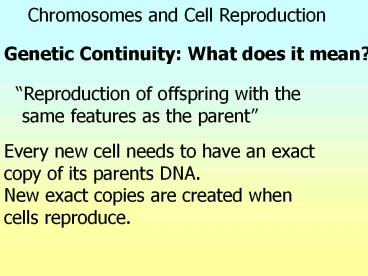Genetic Continuity: What does it mean? PowerPoint PPT Presentation
1 / 23
Title: Genetic Continuity: What does it mean?
1
Chromosomes and Cell Reproduction
Genetic Continuity What does it mean?
Reproduction of offspring with the same
features as the parent
Every new cell needs to have an exact copy of
its parents DNA. New exact copies are created
when cells reproduce.
2
The Cell Cycle
The life of a cell is composed of 2 main parts
1) Interphase the non-reproductive stage where
cell undergoes normal cell function.
2) Mitosis Series of events that make up the
reproductive stage of cell life.
3
Cycle End
Cycle Start
Mitosis
Interphase
4
Interphase non-reproductive portion of cell
cycle
-cell undergoes normal functions
-nuclear material (DNA) is duplicated during
late interphase
-cell organelles are also duplicated
WHY are the DNA and organelles duplicated?
5
Interphase
Animal Plant
6
Prophase the start of mitosis
-nuclear membrane breaks down
-chromosomes coil thicker,shorter
-spindle fibers form, will anchor chromosomes to
poles of cell
Why does the nuclear membrane need to break down?
Why does DNA have to form chromosomes for cell
division?
7
Prophase
Animal Plant
8
Metaphase
-chromosome pairs migrate toward equator of cell
-centromere of each chromosome firmly attaches
to spindle fiber
What is the purpose of a centromere?
9
Metaphase
Animal Plant
10
Anaphase
-centromeres split
-replicated chromosomes move apart
-cell membrane begins to pinch inward
-in plants, new cell wall starts to form, called
the cell plate
11
Anaphase
Animal Plant
12
Telophase
-cell division is almost complete
-spindle fibers dissolve
-chromosomes uncoil, become longer and thinner
again.
-cytokinesis begins
13
Telophase
Animal Plant
14
Cytokinesis
-the cytoplasm of the cells is divided.
-new cell membrane is formed, and encloses both
cells.
-in plants, new cell wall is complete
-two genetically identical daughter cells are
formed
15
Chromosome Number -Each species of organism has a
specific number of chromosomes.
Example Humans have 46 chromosomes, Fruit flies
have 8 chromosomes
16
Most organisms have their chromo- somes arranged
in pairs.
Cells with 2 of each chromosome are called
diploid.
The diploid number of chromosomes is represented
by 2n, where n is the number of different pairs
of chromo- somes
17
Example Humans have 46 chromosomes, arranged in
23 pairs. n23, so 2n 46
Fruit flies have 8 chromosomes, arranged in 4
pairs. n 4, so 2n8
18
In diploid cells, each member of a pair has the
same basic structure.
The 2 members of a pair are called homologs, and
the pair is called a homologous pair
19
Example Each member of a homologous pair may
carry the gene for eye color
1 member may carry the gene for blue eyes, the
other member may carry the gene for brown eyes.
The combination of both genes will determine the
trait that is expressed.
20
Normal Male Human Karyotype
21
Meiosis Cell division that reduces the
chromosome number by 1/2.
The result is cells with the haploid number of
chromosomes.
22
The haploid number is represented by n.
Example In humans, the diploid number is 2n, or
46
The haploid number is 23.
23
Meiosis makes it possible for sexual reproduction,
and therefore the recombination of genes, to
occur. Sex cells are called gametes, and are
either sperm from males, or eggs (ovum) from
females. Sperm and eggs are both haploid.

